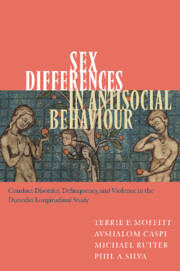 Sex Differences in Antisocial Behaviour
Sex Differences in Antisocial Behaviour Book contents
- Frontmatter
- Contents
- List of figures
- List of tables
- Preface
- Acknowledgements
- 1 Introduction
- 2 The Dunedin Multidisciplinary Health and Development Study
- 3 Sex differences in the amount of antisocial behaviour: dimensional measures
- 4 Sex differences in the prevalence of antisocial behaviour: categorical diagnostic measures
- 5 Sex differences in physical violence and sex similarities in partner abuse
- 6 Sex and the developmental stability of antisocial behaviour
- 7 Sex and the age of onset of delinquency and conduct disorder
- 8 Sex effects in risk predictors for antisocial behaviour: are males more vulnerable than females to risk factors for antisocial behaviour?
- 9 Sex effects in risk predictors for antisocial behaviour: are males exposed to more risk factors for antisocial behaviour?
- 10 Can sex differences in personality traits help to explain sex differences in antisocial behaviour?
- 11 Sex and comorbidity: are there sex differences in the co-occurrence of conduct disorder and other disorders?
- 12 Do girls who develop antisocial behaviour surmount a higher threshold of risk than their male counterparts?
- 13 Sex differences in the effects of antisocial behaviour on young adult outcomes
- 14 Sex, antisocial behaviour, and mating: mate selection and early childbearing
- 15 Evaluating the recommendation to relax the criteria for diagnosing conduct disorder in girls
- 16 Life-course persistent and adolescence-limited antisocial behaviour among males and females
- 17 Priorities for a research agenda
- References
- Index
8 - Sex effects in risk predictors for antisocial behaviour: are males more vulnerable than females to risk factors for antisocial behaviour?
Published online by Cambridge University Press: 22 September 2009
- Frontmatter
- Contents
- List of figures
- List of tables
- Preface
- Acknowledgements
- 1 Introduction
- 2 The Dunedin Multidisciplinary Health and Development Study
- 3 Sex differences in the amount of antisocial behaviour: dimensional measures
- 4 Sex differences in the prevalence of antisocial behaviour: categorical diagnostic measures
- 5 Sex differences in physical violence and sex similarities in partner abuse
- 6 Sex and the developmental stability of antisocial behaviour
- 7 Sex and the age of onset of delinquency and conduct disorder
- 8 Sex effects in risk predictors for antisocial behaviour: are males more vulnerable than females to risk factors for antisocial behaviour?
- 9 Sex effects in risk predictors for antisocial behaviour: are males exposed to more risk factors for antisocial behaviour?
- 10 Can sex differences in personality traits help to explain sex differences in antisocial behaviour?
- 11 Sex and comorbidity: are there sex differences in the co-occurrence of conduct disorder and other disorders?
- 12 Do girls who develop antisocial behaviour surmount a higher threshold of risk than their male counterparts?
- 13 Sex differences in the effects of antisocial behaviour on young adult outcomes
- 14 Sex, antisocial behaviour, and mating: mate selection and early childbearing
- 15 Evaluating the recommendation to relax the criteria for diagnosing conduct disorder in girls
- 16 Life-course persistent and adolescence-limited antisocial behaviour among males and females
- 17 Priorities for a research agenda
- References
- Index
Summary
In previous chapters we saw evidence that males are more antisocial than females. In the next three chapters we ask if the aetiology of antisocial behaviour differs for males and females. This chapter takes a first look at this question by testing the hypothesis that males are more vulnerable than females to individual, familial, and environmental risk factors for antisocial behaviour. The basic premise is that biological sex or psychological gender serve either to exacerbate the influence of the risk factor or conversely to protect the individual from its influence.
Three types of research designs have been used to try to address the question of whether certain risk factors have a greater influence on the development of antisocial behaviour in males versus females. One approach is to use behavioural genetic designs to examine whether there are any sex differences in the genetic and environmental aetiology of antisocial behaviour. The available evidence suggests that estimates are more similar than different among males and females for genetic and environmental liability for externalizing behaviour problems (Gjone, Stevenson, and Sundet, 1996; Gjone et al., 1996), conduct problems (Cadoret and Cain, 1980; Cadoret et al., 1995; Slutske et al., 1997), and crime (Baker et al., 1989; Gottesman, Goldsmith, and Carey, 1997). Two studies that have found sex differences in the magnitude of genetic and environmental influences on antisocial behaviour reached opposite conclusions (Eley et al., 1999; Silberg et al., 1994).
- Type
- Chapter
- Information
- Sex Differences in Antisocial BehaviourConduct Disorder, Delinquency, and Violence in the Dunedin Longitudinal Study, pp. 90 - 108Publisher: Cambridge University PressPrint publication year: 2001


